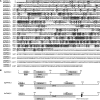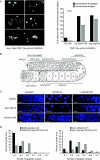DOG-1 is the Caenorhabditis elegans BRIP1/FANCJ homologue and functions in interstrand cross-link repair
- PMID: 18086896
- PMCID: PMC2258786
- DOI: 10.1128/MCB.01641-07
DOG-1 is the Caenorhabditis elegans BRIP1/FANCJ homologue and functions in interstrand cross-link repair
Abstract
Fanconi anemia (FA) is a cancer susceptibility syndrome characterized by defective DNA interstrand cross-link (ICL) repair. Here, we show that DOG-1 is the Caenorhabditis elegans homologue of FANCJ, a helicase mutated in FA-J patients. DOG-1 performs a conserved role in ICL repair, as dog-1 mutants are hypersensitive to ICL-inducing agents, but not to UVC irradiation or X rays. Genetic analysis indicated that dog-1 is epistatic with fcd-2 (C. elegans FANCD2) but is nonepistatic with brc-1 (C. elegans BRCA1), thus establishing the existence of two distinct pathways of ICL repair in worms. Furthermore, DOG-1 is dispensable for FCD-2 and RAD-51 focus formation, suggesting that DOG-1 operates downstream of FCD-2 and RAD-51 in ICL repair. DOG-1 was previously implicated in poly(G)/poly(C) (G/C) tract maintenance during DNA replication. G/C tracts remain stable in the absence of ATL-1, CLK-2 (FA pathway activators), FCD-2, BRC-2, and MLH-1 (associated FA components), implying that DOG-1 is the sole FA component required for G/C tract maintenance in a wild-type background. However, FCD-2 is required to promote deletion-free repair at G/C tracts in dog-1 mutants, consistent with a role for FA factors at the replication fork. The functional conservation between DOG-1 and FANCJ suggests a possible role for FANCJ in G/C tract maintenance in human cells.
Figures





Similar articles
-
C. elegans FANCD2 responds to replication stress and functions in interstrand cross-link repair.DNA Repair (Amst). 2006 Nov 8;5(11):1398-406. doi: 10.1016/j.dnarep.2006.06.010. Epub 2006 Aug 17. DNA Repair (Amst). 2006. PMID: 16914393
-
FANCJ helicase defective in Fanconia anemia and breast cancer unwinds G-quadruplex DNA to defend genomic stability.Mol Cell Biol. 2008 Jun;28(12):4116-28. doi: 10.1128/MCB.02210-07. Epub 2008 Apr 21. Mol Cell Biol. 2008. PMID: 18426915 Free PMC article.
-
C. elegans: a model of Fanconi anemia and ICL repair.Mutat Res. 2009 Jul 31;668(1-2):103-16. doi: 10.1016/j.mrfmmm.2008.11.007. Epub 2008 Nov 19. Mutat Res. 2009. PMID: 19059419 Review.
-
FANCJ helicase operates in the Fanconi Anemia DNA repair pathway and the response to replicational stress.Curr Mol Med. 2009 May;9(4):470-82. doi: 10.2174/156652409788167159. Curr Mol Med. 2009. PMID: 19519404 Free PMC article. Review.
-
Fanconi anemia group J mutation abolishes its DNA repair function by uncoupling DNA translocation from helicase activity or disruption of protein-DNA complexes.Blood. 2010 Nov 11;116(19):3780-91. doi: 10.1182/blood-2009-11-256016. Epub 2010 Jul 16. Blood. 2010. PMID: 20639400 Free PMC article.
Cited by
-
Bioinformatics analysis identify novel OB fold protein coding genes in C. elegans.PLoS One. 2013 Apr 25;8(4):e62204. doi: 10.1371/journal.pone.0062204. Print 2013. PLoS One. 2013. PMID: 23638006 Free PMC article.
-
Spectrum of variations in dog-1/FANCJ and mdf-1/MAD1 defective Caenorhabditis elegans strains after long-term propagation.BMC Genomics. 2015 Mar 18;16(1):210. doi: 10.1186/s12864-015-1402-y. BMC Genomics. 2015. PMID: 25880765 Free PMC article.
-
G Quadruplex in Plants: A Ubiquitous Regulatory Element and Its Biological Relevance.Front Plant Sci. 2017 Jul 4;8:1163. doi: 10.3389/fpls.2017.01163. eCollection 2017. Front Plant Sci. 2017. PMID: 28725233 Free PMC article. Review.
-
Mitotic homologous recombination maintains genomic stability and suppresses tumorigenesis.Nat Rev Mol Cell Biol. 2010 Mar;11(3):196-207. doi: 10.1038/nrm2851. Nat Rev Mol Cell Biol. 2010. PMID: 20177395 Free PMC article. Review.
-
Regulation of homologous recombination in eukaryotes.Annu Rev Genet. 2010;44:113-39. doi: 10.1146/annurev-genet-051710-150955. Annu Rev Genet. 2010. PMID: 20690856 Free PMC article. Review.
References
-
- Arlt, M. F., S. G. Durkin, R. L. Ragland, and T. W. Glover. 2006. Common fragile sites as targets for chromosome rearrangements. DNA Repair 51126-1135. - PubMed
-
- Boulton, S. J., A. Gartner, J. Reboul, P. Vaglio, N. Dyson, D. E. Hill, and M. Vidal. 2002. Combined functional genomic maps of the C. elegans DNA damage response. Science 295127-131. - PubMed
-
- Boulton, S. J., J. S. Martin, J. Polanowska, D. E. Hill, A. Gartner, and M. Vidal. 2004. BRCA1/BARD1 orthologs required for DNA repair in Caenorhabditis elegans. Curr. Biol. 1433-39. - PubMed
Publication types
MeSH terms
Substances
LinkOut - more resources
Full Text Sources
Molecular Biology Databases
Research Materials
Miscellaneous
